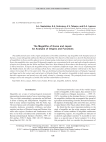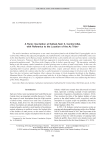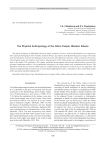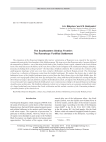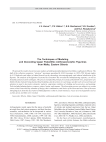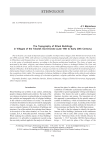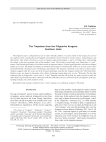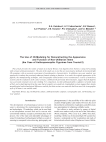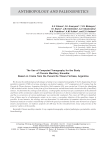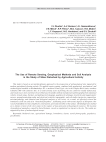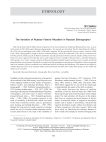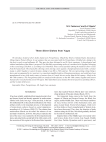Статьи журнала - Archaeology, Ethnology & Anthropology of Eurasia
Все статьи: 351
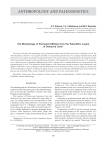
The morphology of permanent molars from the Paleolithic layers of Denisova cave
Статья обзорная
Бесплатно
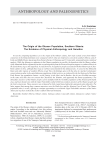
Статья
To test the competing hypotheses as to the origin of the Okunev culture, four male cranial series from Okunev cemeteries in the Minusinsk Basin were compared with 23 other pre-Andronovo series from southern Siberia, and 45 Early and Middle Bronze Age groups from Eastern Europe (24 Yamnaya and 21 Catacomb), using multivariate statistical analysis. While the Afanasyevo admixture in the Okunev population is possible, the hypothesis that the Okunev culture of the Minusinsk Basin originated from the second migration from the Eastern European steppes to southern Siberia in the Early Bronze Age is not supported. It could, however, be applied to people associated with the Okunev-type (Chaa- Khol) culture in Tuva, although these may as well have descended from the Afanasyevans. As concerns the Minusinsk Basin and other regions of southern Siberia except Tuva, the fi ndings agree with the idea of a marked evolutionary conservatism peculiar to the autochthonous populations of that territory, as evidenced by the fact that each of the three Early Bronze Age population clusters—on the Yenisei, in the Altai, and in Baraba—has its own Neolithic ancestors in the same area (this does not concern the Chaa-Khol, the Yelunino, and apparently the Samus populations). The immediate ancestors of the Okunev people can be identifi ed with the Neolithic population of the Krasnoyarsk-Kansk area, and more distant ones with the Upper Paleolithic southern Siberian common ancestors of the Okunev people and the Native Americans. These ancestors are evidenced by both cranial data (indirectly) and genetic data (directly). The la tter suggest that among these common ancestors were the Malta boy and the Afontova Gora II male. The Okunev population, then, is a relic, offeri ng us a unique opportunity to see what the Upper Paleolithic ancestors of the Native Americans may have looked like in their southern Siberian homeland.
Бесплатно
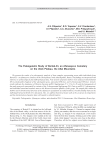
The paleogenetic study of Bertek-33, an Afanasyevo cemetery on the Ukok plateau, the Altai Mountains
Статья
We present the results of a paleogenetic analysis of bone samples representing seven adult individuals from Bertek-33—an Afanasyevo cemetery on the Ukok plateau, in the Altai Republic, Russia. The fi ndings are interpreted with reference to archaeological and anthropological data. Four systems of genetic markers were analyzed: mitochondrial DNA, polymorphic fragment of the amelogenin gene, autosomal STR-loci, and Y-chromosomal STR-loci. Genetic results indicate the dominance of Western Eurasian mtDNA haplogroups (T, J, U5a, K, H) and the homogeneity of the male gene-pool represented by variants of the Y-chromosomal haplogroup R1b. Data on mtDNA, Y-chromosome, and individual autosomal markers attest to the Western Eurasian affi nities of this group. The sample falls within the mtDNA and Y-chromosomal diversity of the Afanasyevo population of southern Siberia. Possible kinship between the individuals buried at Bertek-33 is discussed. Also, we address theoretical issues such as the accuracy of comparisons and the interpretation of genetic data with regard to cultural features.
Бесплатно
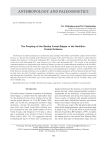
The peopling of the Baraba forest-steppe in the Neolithic: cranial evidence
Статья обзорная
Бесплатно
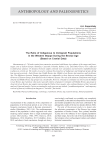
Статья
Measurements of ~730 male crania from cemeteries associated with Bronze Age cultures of the steppe and foreststeppe zone of Eastern Europe (Yamnaya, Catacomb, Poltavka, Babino, Lola, and Timber-Grave) were subjected to multivariate analyses. D2 distances between sample centroids were calculated, and non-metric multidimensional scaling was carried out. The results are used to evaluate the proportion of indigenous and immigrant groups during four successive periods—Early Bronze Age, Middle Bronze Age, Middle to Late Bronze Age transition, and Late Bronze Age. The differences between Yamnaya populations are comparable to those between recent groups inhabiting vast territories of Eastern Europe, from Karelia to the Northern Caucasus. The ro le of the substrate component in the origin of Early and Middle Bronze Age groups was considerable. However, virtually no continuity was observed at the Middle to Late Bronze Age transition, when post-Catacomb cultures originated. Continuity with Middle Bronze Age groups is observed in Late Bronze Age samples representing the Timber-Grave people, who combined features of the Catacomb and post-Catacomb people. Factors accounting for such a process may include “pendulum migrations” and temporary reversal of funerary tradition from kurgans to “invisible” fl at burials.
Бесплатно
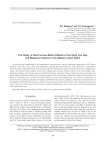
Статья научная
We describe the morphological and quantitative characteristics, and the elemental composition, of 23 bronze artifacts, seven silver ones, and a gold adornment, spanning the period from late 11th century BC to 15th century AD. These items (adornments and tools) belong to the Uril and Talakan cultures of the Early Iron Age, Mikhailovka, Mohe, and Central Asian cultures of the Early Middle Ages, and the Ducher culture of the Late Middle Ages. Elemental analysis of the bronze items at the SB RAS Institute of Nuclear Physics Siberian Center for Synchrotron and Terahertz Radiation Station of Local and Scanning X-Ray Fluorescence Elemental Analysis showed that over about 2.5 thousand years, tin-lead or lead-tin bronze was used for manufacture. Also, the best convergence of concentrations of chemical elements for Talakan and Mikhailovka artifacts testifies to evolutionary continuity between the Talakan and Mikhailovka cultures. Analysis of the elemental composition of Mohe silver and gold items from the Amur basin was carried out for the first time, revealing the high purity of precious metals used for manufacturing early medieval jewelry.
Бесплатно
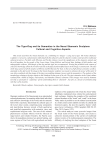
The tiger-dog and its semantics in the Nanai Shamanic sculpture: cultural and cognitive aspects
Статья научная
This article describes the Nanai shamanic set, combining two images—a dog and a tiger. The Nanai shamanic sculpture is viewed as a phenomenon reflecting both the subjective and the objective reality constructed by traditional cultural practices. Parallels with Siberian and Pacific cultures reveal the significance of the domestic animal and the wild predator for the people of the Lower Amur. Using folkloric and lexical data, findings of field studies, and ethnographic evidence, folk images of the dog and the tiger are reconstructed. Viewing the problem in the context of collective knowledge about the world reveals the archetypical and modified layers in the image’s construction. The idea of the dog, typical of all the peoples of Siberia and the Russian Far East, is that of a draft animal, assistant, sacrifice, and guide to the afterworld. Its image in the Nanai shamanic sculpture was meant to enhance the power of the spirit. It was often combined with the image of the tiger, personifying shaman’s power and the progenitors. The analysis of the terminology relating to the tiger attests to the Southeast Asian roots of its cult. The tiger semantics in the Nanai culture resulted from a blend of Tungus, Paleoasiatic, and Manchu (Chinese) elements. These images were used by shamans not only as assistants in “capturing” spirits and holding them in “detention”, but also as a means of communicating with the world of spirits.
Бесплатно
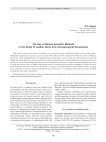
The use of natural scientific methods in the study of leather items from archaeological excavations
Статья
Бесплатно

